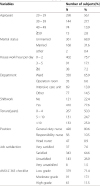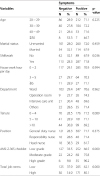1. Marras WS, Cutlip RG, Burt SE, Waters TR. National occupational research agenda (NORA) future directions in occupational musculoskeletal disorder health research. Appl Ergon. 2009; 40(1):15–22. DOI:
10.1016/j.apergo.2008.01.018. PMID:
18462703.
2. Hong K, Kim D, Kwon O, Kim E. The prevalence of work related sickness absences according to the second Korean working condition survey. Korean J Occup Environ Med. 2011; 23(4):428–438.
3. Bernard BP. Musculoskeletal disorders and workplace factors: A critical review of epidemiologity, and low back. (NIOSH publication No. 97-141). 1997. Cincinnati, OH: US Department of health and human services.
4. Barbanel CS. Medical Center Occupational Health and Safety. In : McCunney RJ, editor. Medical Center Occupational Health and Safety. Philadelphia: Lippincott Williams and Wilkins;1999. p. 1–14.
6. Park JK, KIM DS, Jang SH, Heo KH, Joh JH, Woh HS, Shin YM. Risk factors of occupational stress and musculoskeletal disease of nursing worker (translated by Ryu EK). 2010. Incheon: Korea Occupational Safety and Health Agency;p. 1–157.
7. Brulin C, Gerdle B, Hoog J, Ksutson A, Sundelin G. Physical and psychosocial work-related risk factors associated with musculoskeletal symptoms among home care personnel. Scand J Caring Sci. 1998; 12(2):104–110. DOI:
10.1111/j.1471-6712.1998.tb00483.x. PMID:
9801631.
9. Allen A. On-the-job injury: A costly problem. J Post Anesth Nurs. 1990; 5(5):367–368. PMID:
2145428.
10. Sosnowitz BG, Hriceniak JP. Neonatal intensive care units can be hazardous to nurse'health. J Perinatol. 1998; 8(3):253–257. PMID:
3225668.
11. Trinkoff AM, Storr CL, Lipscomb JA. Physically demanding work and inadequate sleep, pain medication use, and absenteeism in registered nurses. J Occup Environ Med. 2001; 43(4):355–363. DOI:
10.1097/00043764-200104000-00012. PMID:
11322096.
12. Kant IJ, Jong JC, Van RM, Borm PJ. A survey of static and dynamic work postures of operating room staff. Int Arch Occup Environ Health. 1992; 63(6):423–428. DOI:
10.1007/BF00386939. PMID:
1544692.
13. Park J, Kang MK, Lee YS, Kang SD, Kim CH. The prevalence of Musculoskeletal symptom and its related factors among nurses in a university hospital. J of chosun univ. 2003; 2(28):81–89.
14. Kim DS, Park JK, Kim KS. Korea Occupational Safety and Health Agency. Guideline of harmful factors survey for musculoskeletal overloading works. cited 8 August 2007. Available:
http://www.kosha.or.kr/content.do?menuId=1751.
15. Park KS, Kang DM, Lee YH, Woo JH, Shin YC. Development of self administered questionnaire and validity evaluation for American National Standards Z-365 checklist. J Korean Soc Occup Environ Hyg. 2006; 16(2):172–182.
16. Chang SJ. Standardization of job stress measurement scale for korean employee. 2004. Incheon. Korea: OSHRI, Korean Occupational Safety and Health Agency;p. 17–42.
17. Woo NH, Kim SY. Job stress and work related musculoskeletal symptoms of general hospital nurses. Korean J of Occupational health nursing. 2009; 18(2):270–280.
18. Park JK, Jang SH, Hur KH, Lee HY, Choi EY, Cho JH, Woo HS. Musculoskeletal disorders and job stress risk factors in general hospital nurses: nursing tasks and musculoskeletal disorder symptoms. J of the Ergonomics Society of Korea. 2010; 9–86.
19. Sul JG, Kang DM, Lee SI, Kim YK. Dose-response relationships between work-related musculoskeletal neck symptom and physical risk factors (2 year followup study. Korean J Occup Environ Med. 2007; 19(2):145–155.
20. Choi YB, Lee SJ, Song JC, Bae KJ, Park HJ. Association between job-related factors and musculoskeletal symptoms in university hospital Healthcare Workers. Korean J Occup Environ Med. 2012; 24(3):217–228.
21. Kurumatani N, Iki K, Katagi K. Occupational cervicobrachial disorder of nursery school teachers based on subjective symptoms related to OCD. Saynyo Ihaku. 1984; 26(5):389–396.
22. Park CY, Cho KY, Lee SH. Cervicobrachial disorder of female international telephone operators I. subjective symptoms. Korean J of Occup med. 1989; 1(2):141–150.
23. Kourinka I, Forcier L. Work-related musculoskeletal disorders (WMSDs): a reference book for prevention. 1995. London, England: Taylor and Francis.
24. Park HH, Lee KM. The subjective musculoskeletal symptoms of operating room nurses. Korean J of occupational Health Nursing. 2005; 2(14):164–170.
25. Jeong EH, Koo JW. Analysis of musculoskeletal burdened work among nurses at a university hospital. J of the Ergonomics Society of Korea. 2006; 25(3):97–103. DOI:
10.5143/JESK.2006.25.3.097.
26. Kim JY, Kim YM, KIM DS, IM HJ, Kim JH, Kang SK. A result of field survey for ergonomic work risk factors in general hospital. Journal of the Ergonomics Society of Korea. 2007; 3(26):91–100.
27. Lee CO, Ahn YS, Kwak WS, Won JW, Lee SY, Kim CY, Roh JH. Work related musculoskeletal disorders and rrgonomic work posture analysis of operating room nurses. J Korean Soc Occup Environ Hyg. 2009; 19(3):171–181.
28. Attarchi M, Raeisi S, Namvar M, Golabadi M. Association between shift working and musculoskeletal symptoms among nursing personnel. Iran J Nurs Midwifery Res. 2014; 19(3):309–314. PMID:
24949072.
29. Caruso CC, Waters TR. A review of work schedule issues and musculoskeletal disorders with an emphasis on the healthcare sector. Ind Health. 2008; 46:523–534. DOI:
10.2486/indhealth.46.523. PMID:
19088404.
30. Lagerström M, Wenemark M, Hagberg M, Hjelm EW. Occupational and individual factors related to musculoskeletal symptoms in five body regions among Swedish nursing personnel. Int Arch Occup Environ Health. 1996; 68(1):27–35. DOI:
10.1007/BF01831630. PMID:
8847110.
31. Bongers PM, Winter CR, Kompier MA, Hildebrandt VH. Psychosocial factors at work and musculoskeletal disease. Scand J Work Environ Health. 1993; 19(5):297–312. DOI:
10.5271/sjweh.1470. PMID:
8296178.
32. Woh NH, Kim SY. Job stress and work related musculskeletal symptoms of general hospital nurses. Korean J of Occupational health Nursing. 2009; 18(2):27–80.
33. Kim YS, Park JY, Park SY. Relationship between job stress and work-related musculoskeletal symptoms among hospital nurses. J Muscle Joint Health. 2009; 16(1):13–25.
34. Choi WJ, Sung NJ, Kang YJ, Han SH. Validity of NIOSH- and Nordic-style questionnaires in the screening and surveillance of neck and upper extremity work-related musculoskeletal disorders. Korean J Occup Environ Med. 2008; 20(3):205–214.







 PDF
PDF Citation
Citation Print
Print


 XML Download
XML Download